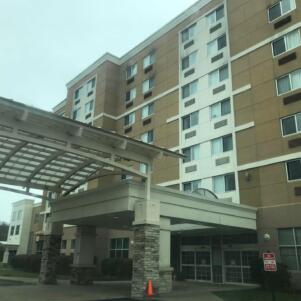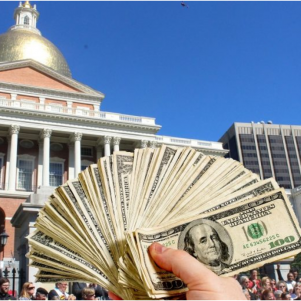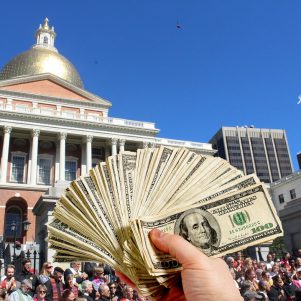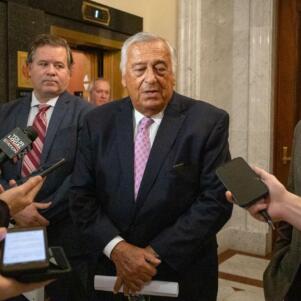‘Crumbling Infrastructure’ A Euphemism for ‘Big Government’
By James P. Freeman | April 12, 2017, 7:26 EDT
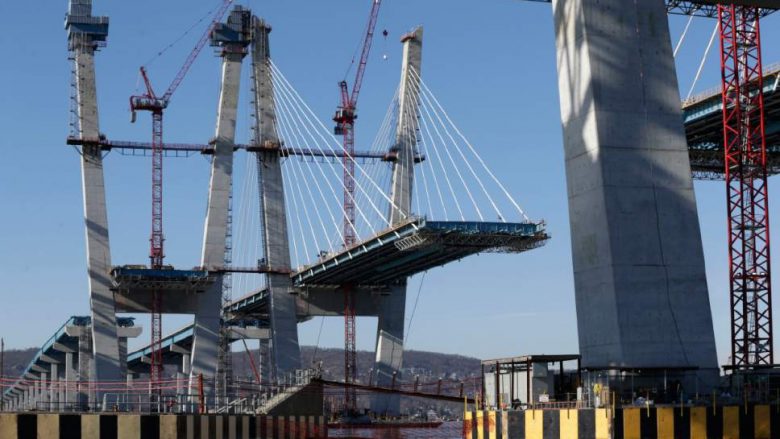 Tappan Zee Bridge project in New York state, shown in December 2016.
//
AP Photo
Tappan Zee Bridge project in New York state, shown in December 2016.
//
AP Photo
With Washington consumed by how President Donald Trump may be redefining the party of Reagan, a closer look at the president’s proposed budget reveals that he may be reviving the politics of Reagan. But brace yourself for the spooky suspense looming with his Reaganesque-ideas on infrastructure.
Released a day before St. Patrick’s Day, “America First: A Budget Blueprint to Make America Great Again,” (the phrase “Make America Great Again” originated from President Ronald Reagan himself) is a trillion-dollar pot in search of fiscal 2018 gold. Trump proposes a large increase in defense spending (over $54 billion) which would be offset by a like-amount decrease in other discretionary spending (environment, housing, transportation). His plan, accordingly, has drawn logical comparisons to Reagan’s first budget.
Dan Balz, writing in The Washington Post, concludes that “Trump’s governing blueprint represents the most ambitious effort to cut domestic spending and pare back the federal government since former president Ronald Reagan came to Washington in 1981.” Whether Trump’s budget “will come close to accomplishing the president’s ambitions is a far different question.”
Indeed, the budget, as outlined thus far, does not achieve fiscal stability, which should alarm crusading Trump supporters; it still allows a deficit and it adds to the federal debt. More importantly, his budget does not address a hopelessly un-conservative project, the massive trillion-dollar infrastructure project.
During his speech to a joint session of Congress in February — evidently relying upon his experience at building buildings — Trump called on members to procure $1 trillion for infrastructure investment for “our national rebuilding.” To be financed “through both public and private capital” (presumably to take the stigma off what will be perceived as a government stimulus program — remember Obama’s $787 billion “shovel ready” program in 2009, that wasn’t shovel ready?), the president hopes it will create “millions” of new jobs. The New York Times, with progressive glee, says such spending aims at “restoring the country’s crumbling bridges, potholed roads, rust-bucket trains and shabby-not-chic airports.”
The infrastructure adventure is the third piece in Trump’s troika of supposed better (read big, not limited) government initiatives, as articulated by Office of Management and Budget (OMB) Director Mick Mulvaney. Appearing on “Meet-The-Press,” Mulvaney said the administration would first “do health reform,” then “tax reform after that,” and, finally, “infrastructure probably sometime around summer or early fall.” He also admitted that the administration hopes to have a balanced budget in ten years and that future spending would add to the debt each year for the next ten years. Weren’t eliminating the deficit and reducing the debt among the many campaign promises of candidate Trump? (For fiscal year 2018, the deficit is projected to be $480 billion.)
Asked if he has “figured out how to pay for the trillion-dollar infrastructure yet,” Mulvaney responded: “No, but in all fairness, there’s some great ideas, things that I think — one of the neat things about having a business man in the office and all of these folks come from the private sector, is they brought ideas that I don’t think government has ever contemplated before.” Perhaps it will showcase swashbuckling Brand Trump financial engineering from his go-go years. (Read about his debt-financed, bankruptcy-assured casino “investments” in the late 1980s and early 1990s.)
Trump’s previous experience with the kind of public-private-partnerships he now happily espouses was with the tiny Woolman Rink project in the 1980s. Then, developer Trump refurbished the Central Park skating rink, something that municipal officials found impossible to accomplish. Upon completion, Trump displayed his now-legendary hyperbole by saying, “If we could just plan and execute, it would be billions and billions of dollars that would be saved.”
David Stockman, Office of Management and Budget director during Reagan’s first term, sees parallels between Trump’s and Reagan’s unwise devotion to infrastructure in his book Trumped!: A Nation On the Brink of Ruin… And How to Bring It Back.
Reagan initially resisted the temptation to implement a “Keynesian-style fiscal-stimulus and jobs program” during the 1981-82 recession. But he eventually acquiesced and signed a “pork-laden” highway bill (the Surface Transportation Assistance Act of 1982) and said, “we have 23,000 bridges in need of replacement or repair…This program is an investment in tomorrow.” Trump echoed similar nonsense on the campaign trail in 2015 when he claimed, “Sixty-one percent of our bridges are in trouble. Do you believe this? We drive over a bridge, it’s in trouble.”
In the chapter “America’s Bridges Are Not Falling Down: The Perennial Myth of Crumbling Infrastructure,” he argues that 95 percent of infrastructure is not a federal responsibility. This, writes Stockman, “should be managed by state and local governments and be funded by local users and taxpayers.”
Stockman shows how policy makers arrive at their faulty assessments about the crumbling national infrastructure — by misusing the federal gasoline tax and by not questioning the actual number of so-called structurally deficient bridges. He asserts that, after decades of federal “mission creep,” there is “virtually no aspect of ‘infrastructure’ spending that has not wormed its way into the federal budget.”
Believing that the nation is heading into a “fiscal bloodbath,” Stockman offers a sobering evaluation of Trump: he knows “a lot about debt, and its dangers when it gets out of hand, and almost nothing about the economics of growth and public infrastructure.” Here is where the comparison to Reagan should stop. As a two-term governor of California, at least Reagan knew something about public works, even if he was wrong about embracing big programs as president.
The infrastructure proposal is the latest confirmation — do we need more? — that Trump is a political exhibitionist, streaking through establishment Washington, mooning traditional conservatives, eluding intellectual explanation, all while attesting to self-importance. In his supreme arrogance, he must believe that his next-to-no experience with government projects is not problematic and that his personal chutzpah will be sufficiently effective as a tool to oversee a trillion-dollar Beltway Boondoggle.
James P. Freeman is a New England-based writer and former columnist with The Cape Cod Times.

